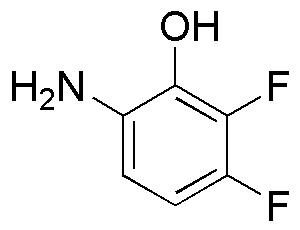6-Amino-2,3-difluorophenol is widely utilized in research focused on:
- Pharmaceutical Development: This compound serves as a key intermediate in the synthesis of various pharmaceutical agents, particularly those targeting neurological disorders. Its unique fluorine substitutions enhance biological activity and selectivity.
- Agricultural Chemicals: It is used in the formulation of agrochemicals, including herbicides and fungicides, providing improved efficacy and reduced environmental impact compared to traditional compounds.
- Analytical Chemistry: The compound is employed as a reagent in analytical methods for detecting and quantifying phenolic compounds in environmental samples, aiding in pollution monitoring.
- Material Science: Its properties make it suitable for developing advanced materials, such as polymers and coatings, that require enhanced thermal stability and chemical resistance.
- Research in Biochemistry: The compound is utilized in biochemical assays to study enzyme interactions and mechanisms, providing insights that can lead to new therapeutic strategies.
General Information
Properties
Safety and Regulations
Applications
6-Amino-2,3-difluorophenol is widely utilized in research focused on:
- Pharmaceutical Development: This compound serves as a key intermediate in the synthesis of various pharmaceutical agents, particularly those targeting neurological disorders. Its unique fluorine substitutions enhance biological activity and selectivity.
- Agricultural Chemicals: It is used in the formulation of agrochemicals, including herbicides and fungicides, providing improved efficacy and reduced environmental impact compared to traditional compounds.
- Analytical Chemistry: The compound is employed as a reagent in analytical methods for detecting and quantifying phenolic compounds in environmental samples, aiding in pollution monitoring.
- Material Science: Its properties make it suitable for developing advanced materials, such as polymers and coatings, that require enhanced thermal stability and chemical resistance.
- Research in Biochemistry: The compound is utilized in biochemical assays to study enzyme interactions and mechanisms, providing insights that can lead to new therapeutic strategies.
Documents
Safety Data Sheets (SDS)
The SDS provides comprehensive safety information on handling, storage, and disposal of the product.
Product Specification (PS)
The PS provides a comprehensive breakdown of the product’s properties, including chemical composition, physical state, purity, and storage requirements. It also details acceptable quality ranges and the product's intended applications.
Certificates of Analysis (COA)
Search for Certificates of Analysis (COA) by entering the products Lot Number. Lot and Batch Numbers can be found on a product’s label following the words ‘Lot’ or ‘Batch’.
Número de catálogo
Número de lote/lote
Certificates Of Origin (COO)
This COO confirms the country where the product was manufactured, and also details the materials and components used in it and whether it is derived from natural, synthetic, or other specific sources. This certificate may be required for customs, trade, and regulatory compliance.
Número de catálogo
Número de lote/lote
Safety Data Sheets (SDS)
The SDS provides comprehensive safety information on handling, storage, and disposal of the product.
DownloadProduct Specification (PS)
The PS provides a comprehensive breakdown of the product’s properties, including chemical composition, physical state, purity, and storage requirements. It also details acceptable quality ranges and the product's intended applications.
DownloadCertificates of Analysis (COA)
Search for Certificates of Analysis (COA) by entering the products Lot Number. Lot and Batch Numbers can be found on a product’s label following the words ‘Lot’ or ‘Batch’.
Número de catálogo
Número de lote/lote
Certificates Of Origin (COO)
This COO confirms the country where the product was manufactured, and also details the materials and components used in it and whether it is derived from natural, synthetic, or other specific sources. This certificate may be required for customs, trade, and regulatory compliance.


